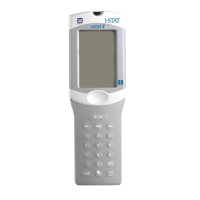Glu - 2 Art: 714177-00N Rev. Date: 03-Aug-12
Expected Values
Reportable Reference
Test/Abbreviation Units* Range Range
2
Glucose/Glu mg/dL 20 – 700 70 – 105
(fasting) mmol/L 1.1 – 38.9 3.9 – 5.8
g/L 0.20 – 7.00 0.70 – 1.05
* The i-STAT System can be configured with the preferred units.
To convert a result from mg/dL to mmol/L, multiply the mg/dL value by 0.055.
The i-STAT reference ranges for whole blood listed above are similar to reference ranges derived from serum
or plasma measurements with standard laboratory methods.
The reference range programmed into the analyzer and shown above is intended to be used as a guide
for the interpretation of results. Since reference ranges may vary with demographic factors such as
age, gender and heritage, it is recommended that reference ranges be determined for the population
being tested.
Clinical Significance
Glucose is a primary energy source for the body and the only source of nutrients for brain tissue.
Measurements for determination of blood glucose levels are important in the diagnosis and treatment of
patients suffering from diabetes and hypoglycemia. Some causes for increased values of glucose include
diabetes mellitus, pancreatitis, endocrine disorders (e.g. Cushing’s syndrome), drugs (e.g. steroids,
thyrotoxicosis), chronic renal failure, stress, or I.V. glucose infusion. Some causes of decreased values of
glucose include insulinoma, adrenocortical insufficiency, hypopituitarism, massive liver disease, ethanol
ingestion, reactive hypoglycemia, and glycogen storage disease.
Performance Characteristics
The typical performance data summarized below was collected in health care facilities by health care
professionals trained in the use of the i-STAT System and comparative methods.
Precision data were collected at multiple sites as follows: Duplicates of each control fluid were tested in the
morning and in the afternoon on five days for a total of 20 replicates. The averaged statistics are presented
below.
Method comparison data were collected using CLSI guideline EP9-A
3
. Venous blood samples were
collected in lithium heparin Vacutainer
®
tubes and analyzed in duplicate on the i-STAT System. A portion
of the specimen was centri fuged and the separated plasma was analyzed in duplicate on comparative
methods within 20 minutes of collection.
Deming regression analysis
4
was performed on the first replicate of each sample. In the method comparison
table, n is the number of specimens in the data set, Sxx and Syy refer to estimates of imprecision based
on the duplicates of the comparative and the i-STAT methods respectively, Sy.x is the standard error of the
estimate, and r is the correlation coefficient.*
Method comparisons will vary from site to site due to differences in sample handling, comparative method
calibration and other site specific variables.
Interference studies were based on CLSI guideline EP7.
5
* The usual warning relating to the use of regression analysis is summarized here as a reminder: For any analyte, “if the data is collected over
a narrow range, the estimate of the regression parameters are relatively imprecise and may be biased. Therefore, predictions made from these
estimates may be invalid”.
3
The correlation coefficient, r, can be used as a guide to assess the adequacy of the comparative method range in
overcoming this problem. As a guide, the range of data can be considered adequate if r>0.975.

